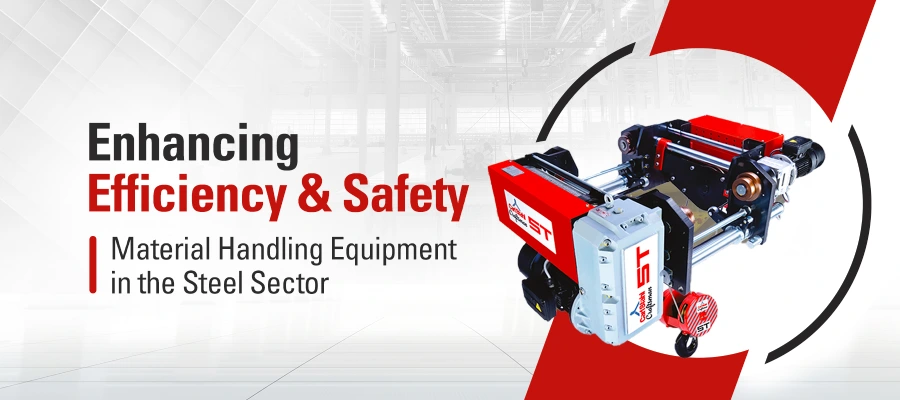Enhancing Efficiency and Safety: Material Handling Equipment in the Steel Sector

- 07 Mar 2024
- By Admin
The steel sector stands as one of the pillars of industrialization, playing a pivotal role in infrastructure development, manufacturing, and construction. Central to the success of this sector is the efficient handling of raw materials, semi-finished, and finished products. Material handling equipment (MHE) plays a crucial role in streamlining operations, optimizing productivity, and ensuring safety within steel plants and facilities.
Streamlining Operations with Material Handling Equipment
1. Raw Material Handling
In the steel sector, raw materials such as iron ore, coal, and scrap metal are handled in large quantities. Heavy-duty equipment like cranes, loaders, and excavators are used to transport and unload raw materials from trucks, trains, or ships to storage yards or directly to processing units.
2. Material Transportation
MHE such as conveyor belts, overhead cranes, and rail-guided vehicles facilitate the movement of materials within the plant. Conveyor systems efficiently transport raw materials to various processing units, reducing manual handling and minimizing the risk of accidents.
3. Processing Equipment
Specialized machinery such as blast furnaces, rolling mills, and ladle cranes are utilized in the processing of raw materials into semi-finished or finished products. These equipment are designed to withstand high temperatures and heavy loads, ensuring continuous operation and optimal output.
4. Storage and Warehousing
MHE including forklifts, stackers, and palletizers are employed for efficient storage and retrieval of finished products. Automated storage and retrieval systems (AS/RS) maximize storage capacity and minimize handling time, contributing to inventory optimization and just-in-time delivery practices.
Optimizing Productivity and Safety
1. Automation and Robotics: Automation technologies such as robotic arms and automated guided vehicles (AGVs) are increasingly integrated into steel manufacturing processes. These robots handle repetitive tasks with precision and speed, improving productivity while reducing the risk of workplace injuries.
2. Safety Measures: Safety is paramount in the steel sector due to the presence of heavy machinery and hazardous materials. MHE are equipped with safety features such as sensors, alarms, and interlocks to prevent accidents and ensure compliance with industry regulations. Additionally, training programs and safety protocols are implemented to educate workers on proper equipment operation and handling procedures.
3. Remote Monitoring and Control: Advanced MHE systems incorporate remote monitoring and control capabilities, allowing operators to oversee operations from a centralized location. Real-time data analytics enable predictive maintenance, minimizing downtime and optimizing equipment performance.
Conclusion
Material handling equipment plays a critical role in the efficiency, productivity, and safety of the steel sector. By investing in advanced MHE technologies and implementing robust safety measures, steel manufacturers can streamline operations, reduce costs, and maintain a competitive edge in the global market. As the demand for steel continues to rise, embracing innovative material handling solutions will be essential for meeting production targets, achieving sustainability goals, and ensuring the long-term success of the industry.
